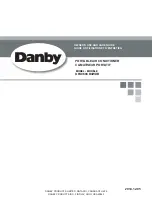
18
19
DANGER OF BODILY INJURY OR
DEATH FROM ELECTRICAL SHOCK
When working on high voltage equipment - turn the
electrical power off before attaching test leads.
Use test leads with alligator type clips - clip to
terminals, turn power on, take reading - turn power
off before removing leads.
Compressor Checks
LOCKED ROTOR VOLTAGE (L.R.V.) TEST
Locked rotor voltage (L.R.V.) is the actual voltage available
at the compressor under a stalled condition.
Single Phase Connections
Disconnect power from unit. Using a voltmeter, attach one
lead of the meter to the run "R" terminal on the compressor
and the other lead to the common "C" terminal of the
compressor. Restore power to unit.
Make sure that the ends of the lead do not touch
the compressor shell since this will cause a short
circuit.
Reversing Valve in Cooling Mode
8. Pressurize sealed system with a combination of R-22
and nitrogen and check for leaks, using a suitable leak
detector. Recover refrigerant per EPA guidelines.
9. Once the sealed system is leak free, install solenoid coil
on new valve and charge the sealed system by weighing
in the proper amount and type of refrigerant as shown
on rating plate. Crimp the process tubes and solder the
ends shut. Do not leave Schrader or piercing valves in
the sealed system.
Determine L.R.V.
Start the compressor with the voltmeter attached; then stop
the unit. Attempt to restart the compressor within a couple
of seconds and immediately read the voltage on the meter.
The compressor under these conditions will not start and will
usually kick out on overload within a few seconds since the
pressures in the system will not have had time to equalize.
Voltage should be at or above minimum voltage of 197 VAC,
as specified on the rating plate. If less than minimum, check
for cause of inadequate power supply; i.e., incorrect wire
size, loose electrical connections, etc.
AMPERAGE (L.R.A.) TEST
The running amperage of the compressor is the most
important of these readings. A running amperage higher
than that indicated in the performance data indicates that
a problem exists mechanically or electrically.
Single Phase Running and L.R.A. Test
NOTE:
Consult the specification and performance section
for running amperage. The L.R.A. can also be found on
the rating plate.
Select the proper amperage scale and clamp the meter probe
around the wire to the "C" terminal of the compressor.
Turn on the unit and read the running amperage on the
meter. If the compressor does not start, the reading will
indicate the locked rotor amperage (L.R.A.).
External Overload
The compressor is equipped with an external overload which
senses both motor amperage and winding temperature.
High motor temperature or amperage heats the overload
causing it to open, breaking the common circuit within the
compressor.
Heat generated within the compressor shell, usually due
to recycling of the motor, is slow to dissipate. It may take
anywhere from a few minutes to several hours for the
overload to reset.
Checking the External Overload
With power off, remove the leads from compressor terminals.
If the compressor is hot, allow the overload to cool before
starting check. Using an ohmmeter, test continuity across
the terminals of the external overload. If you do not have
continuity; this indicates that the overload is open and must
be replaced.
















































